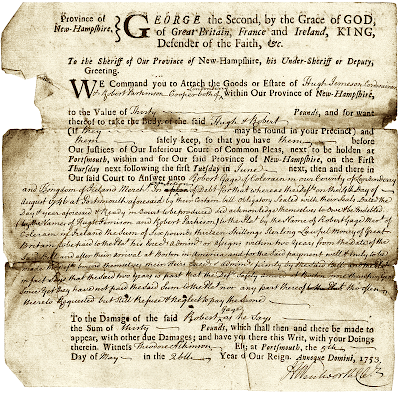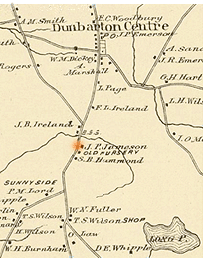.gif) Alexander's payroll card as a New Hampshire Volunteer after the battles of Bennington and Saratoga
Alexander's payroll card as a New Hampshire Volunteer after the battles of Bennington and SaratogaAlexander Jameson (1760-1820) was the first child of Hugh and, his second wife, Jane. He was also the first son born in America to Hugh. Alexander was born in
Dunbarton, likely on the homestead, and remained there well after he had a family of his own, having shared the farm with his brother Daniel.
Alexander followed his father into the ranks of the Continental Army (though he enlisted directly into Moore's
Regiment of the the New Hampshire Militia). Both father and son could likely and honorably avoided service because it was voluntary and their ages: Hugh was 62 at the time of the Battle of Bunker Hill and Alexander was 17 at the time of the Battles of
Saratoga.
As indicated by the Payroll Card (above):
Alexander Jameson
Moore's New Hampshire
Regiment
(Revolutionary War)
================================
Private and discharged as a private
(other side of card)
J Moore's Regiment N.H.
Alex r Jameson
Appears with rank of Pvt on a
Pay Roll
of a Company of Volunteers commanded by Capt.
John Duncan in Col. Daniel Moore's Regiment,
which marched from Bedford, Sept. 1777, to
join the Northern Continental Army,
(Revolutionary War)
dated..........Bedford...................
...................Dec......16.........................,1777
Time of engagement.....Sept....26....,17...
Time of discharge...Oct....25............,17...
Time in the service.....27.......................days.
Rate per month.....L 4, 10
Amount of wages..L 4,....1
Travel from Bedford and Antrim to Beningtown,
135....m. at 3d......L1, 13, 9
Travel home from Saratoga to Bedford and Antrim,
132...m. at 2d....L 1..,2.....
================================
Rations
Whole number ......................................................
Number received..................................................
No. due at 8d.........................................................
Amount..................................................................
=================================
Whole amount ......................6,.....16,.....9...........
Remarks................................................................
................................................................................
=================================
........................................Feaslis.............
(353i)
 Brigadier General John Stark
Brigadier General John StarkJohn Starks was born in Londonderry, New Hampshire. His father had emigrated from northern Ireland and settled in the New Hampshire frontier where he owned extensive tracts of land and was the original proprietor of Dunbarton (originally called Starkstown)
Alexander Jameson served as a private with Colonel Daniel Moore's Regiment of the New Hampshire Volunteers. "They marched from Bedford, NH, to join the Northern Continental Army at Bennington, VT, for what became the battles of Bennington and Saratoga in 1777. The militia were originally created to protect the colonies from attacks by the French and their Indian allies. They had more at stake than the regular army, since they were protecting their own homes.
Colonel Stark and his men (without either Jameson) were dispatched to aid the militias of Massachusetts, who were trying to keep the British in Boston. When they tried to push out of Boston by attacking the colonists, the colonists fought back at the Battle of Bunker Hill (June 17, 1775).
In July, 1777, Stark was offered a commission as Brigadier General of the New Hampshire militia. He accepted with the stipulation that he would be answerable only to New Hampshire, that is, not the Continental Army. Soon after receiving the commission he was ordered to depart New Hampshire to reinforce the Continental Army at Saratoga, NY. He refused. Instead, he led his men to meet the British at Bennington, VT, where Colonel Frederick Baum with about 500 men were about to attack Bennington storehouses to restock their dwindling supplies.
Gen. Stark sent out men to gather recruits. With about 2200 militiamen (some with their own guns and dressed for tending fields) 1400 from NH, the rest from VT, NY, CT and MA. Catching Colonel Baum and the British commanding General Burgoyne. Both colonel Baum's 500 men and 500 re-enforcements sent hurriedly from Burgoyne were soundly defeated. Not more than 100 escaped.
The battles of Bennington, VT and Saratoga, NY are not far from each other
The loss of soldiers and the inability for General Burgoyne to gain supplies led directly to defeats at the battles of Saratoga and the surrender of Burgoyne.
 This map indicates the succession of battles and the sequence which run mostly from north to south. The Battle of Bennington, the Battle of Saratoga
This map indicates the succession of battles and the sequence which run mostly from north to south. The Battle of Bennington, the Battle of Saratoga
Moore's Regiment (the 9th militia) with Alexander Jameson was called up on September 29 and participated in the last battle of Saratoga, October 7, 1777.

With the surrender of General Burgoyne on October 17 (10 days after the final battle of Saratoga) the regiment was disbanded on October 27, 1777.
 The surrender of General Burgoyne to General Gates of the Continental Army.
The surrender of General Burgoyne to General Gates of the Continental Army.
General John Stark gave to Moore's regiment a brass 4 pounder cannon captured at the Battle of Bennington.
 This map indicates the succession of battles and the sequence which run mostly from north to south. The Battle of Bennington, the Battle of Saratoga
This map indicates the succession of battles and the sequence which run mostly from north to south. The Battle of Bennington, the Battle of Saratoga

 The court summons for Hugh Jameson & Robert Parkinson (Photo: Somejamesons)
The court summons for Hugh Jameson & Robert Parkinson (Photo: Somejamesons) Queen Anne (Photo: CoinLink)
Queen Anne (Photo: CoinLink) Dunbarton with Jameson reference at orange spot (photo: SomeJamesons)
Dunbarton with Jameson reference at orange spot (photo: SomeJamesons) Jameson House (Photo: SomeJamesons)
Jameson House (Photo: SomeJamesons)